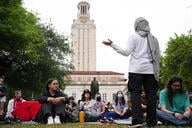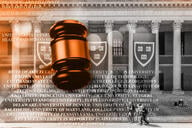You have /5 articles left.
Sign up for a free account or log in.
The students profiled in How Did You Get Here? Students With Disabilities and Their Journeys to Harvard (Harvard Education Press) had much to overcome. They faced a range of disabilities and also attitudes of some who demeaned them and suggested that they wouldn't amount to much. The book is based on interviews with the students about how they persevered, and how they think about Harvard University and their futures. The authors are Thomas Hehir, the Silvana and Christopher Pascucci Professor of Practice in Learning Differences at the Harvard Graduate School of Education, and Laura A. Schifter, an adjunct lecturer at the Harvard Graduate School of Education. They responded via e-mail to questions about the book.
Q: To what extent do you think the students whose stories you tell are reflective of students with disabilities in higher education generally, as opposed to those at Harvard?
A: The themes that emerged across the students’ stories -- the impact of parents, teachers, extracurricular activities and more -- are consistent with other research examining factors that help students succeed. It is also important to note that only three of the students featured in the book were in fact undergraduate students at Harvard. Thirteen of the students featured in the book were master's or doctoral students at the Harvard Graduate School of Education and have a variety of different undergraduate experiences. Some attended large state institutions and others small liberal arts colleges. In telling their stories, many of these students described their experiences during their undergraduate years -- some sharing positive experiences with great disability support offices, while most described struggles in accessing accommodations in higher education. Attending Harvard, some as undergraduates and some as graduate students, demonstrates that all of these students have experienced academic success, but their journeys getting to Harvard are more reflective of the general experience of students with disabilities.
Q: The students repeatedly talk about the role of parents and teachers (when the students were younger) in encouraging them. What can higher education do to encourage this early attention that seems to be so important?
A: One important thing higher education should do is recognize, accept and welcome students with disabilities in higher education. If more institutions of higher education create welcoming environments for students with disabilities, then parents and teachers will see college as a viable option for these children and encourage them on their paths to higher education. Disability service offices can also work with high schools and parents to better support the transition needs of students with disabilities as they enter postsecondary schools. In general, IDEA [Individuals with Disabilities Education Act] is an entitlement right that does not require students to advocate to get their needs addressed. However, when students transition to higher education, they have to advocate for themselves, which can be challenging. Finally, institutions with teacher preparation programs should ensure that the students in these programs are prepared to meet the needs of the students with disabilities they will inevitably teach.
Q: The students you profile have a range of disabilities -- some with dyslexia and others with various physical disabilities. Do you find key differences in the experiences of these groups?
A: Actually, one thing we found somewhat surprising was in fact how many similarities there were across the students’ experiences. Beyond differences in disability category, these students came from different socioeconomic, racial and geographical backgrounds, but their stories had many similarities, from the positive role of professionals to the challenges of accessing accommodations. One slight difference arose in how students with visible disabilities negotiated disability as a part of identity compared with how those students with nonvisible disabilities negotiated their identity. Those students with visible disabilities were forced to address societal perceptions of disability head-on, but those students with nonvisible disabilities describe a struggle in deciding when and to whom to “come out” as disabled.
Q: What do you see as the main barriers for students with disabilities in higher education? Do colleges need more pressure -- such as the lawsuit just filed against Harvard and the Massachusetts Institute of Technology over captioning of course materials -- to meet their responsibilities?
A: One main barrier for students with disabilities in higher education is access to accommodations. Lawsuits are an important tool, but they are not the only tool to help institutions change their practice. Student or faculty organizing can help push change, or school leadership can decide to take it on as a school initiative. Making instruction more accessible for more students won’t come from pressure alone, though -- the schools need to build their capacity to do this well. Faculty will need to learn to address barriers in instruction, and technology will need to be effectively utilized. Universal Design for Learning can be a powerful framework to help colleges better meet the needs of students with disabilities in higher education.
Q: Based on the students you profile, what should professors know about students with disabilities?
A: Professors should know that they will have students with disabilities in their classrooms. More and more students with disabilities are enrolling in higher education, and in fact, the increase in enrollment is outpacing the increases for students without disabilities. Professors also need to understand that disabilities are not always visible, and students may struggle with deciding whether or not to identify themselves. Knowing this, professors should assume diversity in their classes and can work during their course planning to embed accommodations into their instruction. When we have added flexibility into our courses, we have found that other students benefit as well -- English learners, working parents, etc. Thinking this way, to embed rather than retrofit instruction, can be challenging, but it will ultimately improve instruction for all students.




